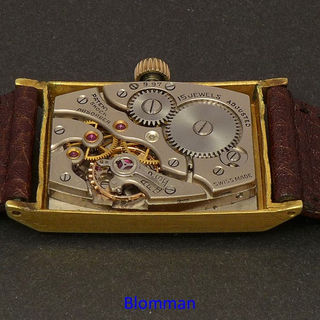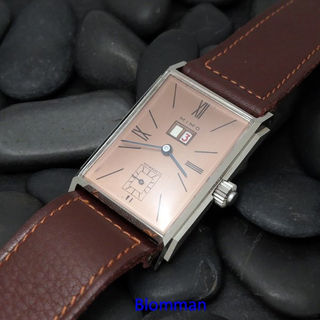
Helvetia Large Date Calendar Watches
The date display in early date watches could be very difficult to see so Helvetia came up with the solution with their 'Large Date' calendar watches.
Scroll down for more...
During the 1930s a number of methods were developed by watch manufacturers to allow the date to be displayed on a watch as well as the time. Several of them produced watches with an easily readable date made up of large numerals, collectively these have become known as ‘Large Date’ or ‘Big Date’ watches.
It has previously been recorded that Paul Ditisheim developed the first large date watch with his company Solvil under their Ditis brand name in 1932, followed by Helvetia in 1934 and Mimo/Girard Perregaux in 1939.

Helvetia’s version of the large date used their calibre 75A movement which was adapted by the addition of two wheels with numerals visible through a window in the dial. The left hand wheel had the numbers 1 to 3 and the right hand 1 to 9.

'Calender-watches with very visible date' - Helvetia Advert Early 1930s

Illustration from the Wilderness Catalogue 1934
To change the date manually you needed to press a button in the centre of the crown which advanced the date by one day this meant you could end up with some strange dates, the 38th for instance!
Mimo/Girard Perregaux also used a version of the Helvetia 75A, re-numbered the GP 97, with their own case and dial for their large date watches later in the 1930s and 1940s.
Looking closely at the 1932 Solvil/Ditis advert I thought that their large date watch looked very similar to the Helvetia version. The picture of the movement in the ad also looked familiar and the fact that they mention it was their new patented shock absorber movement when Helvetia were one of only a few manufacturers to routinely use shock protection at this time prompted me to dig a little deeper.
The movement in the Solvil/Ditis advert is also the Helvetia 75A but with a different bridge configuration to the 75A used in Helvetia and Mimo/Girard Perregaux versions. It looks as if Solvil/Ditis were using the Helvetia case and dial for their watches too.
There are a couple of other pieces of evidence that I have found that support Helvetia being the first to develop the large date watch.
The first is a report from the British publication 'Watch and Clock Maker' of the Basle Watch Fair of April 1934. The report states:
The General Watch Company, whose products are known by the trade mark “Helvetia,” which is the name of Switzerland itself, made a good show of their lines. Most of these are well known in England. One excellent production of this company is a calendar watch in which the date is really visible. They have been making this for years but have not sold it in England. If there is a demand for a date watch, this model should satisfy it.
The second is a design that Helvetia registered in January 1932 as illustrated below. The registered design protects the idea of a watch with a date window and a spinning disk for the seconds display as opposed to the standard hand. Apart from the move to a larger date display made up of two disks this is very similar to the watches shown in the Ditis and Helvetia adverts.
While researching this page I have found another version of the Helvetia large date watch that doesn't seem to have been recorded before, this one made by the Angora Watch Company. The pictures below illustrate niceley how the date discs in the Helvetia movement are configured.
So it seems that all of the large date watches produced in the 1930s were based on the Helvetia 75A and Helvetia was the true inventor of the ‘Large Date’ or ‘Big Date’ watch. Advertising regulations were obviously not as strict in those days with Solvil/Ditis claiming the 75A as their own, it seemed to happen a lot with Helvetia – have look at the Sports Watches and Pilots Watches pages to see G & M Lane claiming all sorts for their Aero and Aeroplane watches which were Helvetia watches with just a different name added to the dial.
Below is an illustration and explanation of how the Big Date watch actually worked.
The hour wheel turns once in 12 hours moving the hour hand. This transfers energy, via an intermediate date wheel, to a date jumper spring which stores the energy until midnight. At midnight the energy is released to the date jumper which turns the ones date disc to the next number. When the ones disc reaches 0 a small triangle on the edge of the disc engages with teeth one the back of the tens disc to advance it one place. The locator springs help to keep the numerals centred in the windows of the dial.
Here is an excellent video showing the complete assembly of the watch above - YouTube
Mimo/Girard Perregaux watches above with thanks to The Blomman Watch Report
Exploded version of the Girard Perregaux watch thanks to Brandon at Fratello Watches and Nabe on YouTube















